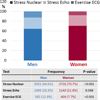Sex Differences in Demographics, Risk Factors, Presentation, and Noninvasive Testing in Stable Outpatients With Suspected Coronary Artery Disease: Insights From the PROMISE Trial
- PMID: 27017234
- PMCID: PMC4982809
- DOI: 10.1016/j.jcmg.2016.02.001
Sex Differences in Demographics, Risk Factors, Presentation, and Noninvasive Testing in Stable Outpatients With Suspected Coronary Artery Disease: Insights From the PROMISE Trial
Abstract
Objectives: The aim of this study was to determine whether presentation, risk assessment, testing choices, and results differ by sex in stable symptomatic outpatients with suspected coronary artery disease (CAD).
Background: Although established CAD presentations differ by sex, little is known about stable, suspected CAD.
Methods: The characteristics of 10,003 men and women in the PROMISE (Prospective Multicenter Imaging Study for Evaluation of Chest Pain) trial were compared using chi-square and Wilcoxon rank-sum tests. Sex differences in test selection and predictors of test positivity were examined using logistic regression.
Results: Women were older (62.4 years of age vs. 59.0 years of age) and were more likely to be hypertensive (66.6% vs. 63.2%), dyslipidemic (68.9% vs. 66.3%), and to have a family history of premature CAD (34.6% vs. 29.3) (all p values <0.005). Women were less likely to smoke (45.6% vs. 57.0%; p < 0.001), although their prevalence of diabetes was similar to that in men (21.8% vs. 21.0%; p = 0.30). Chest pain was the primary symptom in 73.2% of women versus 72.3% of men (p = 0.30), and was characterized as “crushing/pressure/squeezing/tightness” in 52.5% of women versus 46.2% of men (p < 0.001). Compared with men, all risk scores characterized women as being at lower risk, and providers were more likely to characterize women as having a low (<30%) pre-test probability of CAD (40.7% vs. 34.1%; p < 0.001). Compared with men, women were more often referred to imaging tests (adjusted odds ratio: 1.21; 95% confidence interval: 1.01 to 1.44) than nonimaging tests. Women were less likely to have a positive test (9.7% vs. 15.1%; p < 0.001). Although univariate predictors of test positivity were similar, in multivariable models, age, body mass index, and Framingham risk score were predictive of a positive test in women, whereas Framingham and Diamond and Forrester risk scores were predictive in men.
Conclusions: Patient sex influences the entire diagnostic pathway for possible CAD, from baseline risk factors and presentation to noninvasive test outcomes. These differences highlight the need for sex-specific approaches for the evaluation of CAD.
Conflict of interest statement
No other potential conflict of interest relevant to this article was reported.
Figures


Comment in
-
Ischemic Heart Disease in Women: A Need for Sex-Specific Diagnostic Algorithms.JACC Cardiovasc Imaging. 2016 Apr;9(4):347-9. doi: 10.1016/j.jcmg.2016.02.008. JACC Cardiovasc Imaging. 2016. PMID: 27017235 No abstract available.
-
Coronary disease: Sex differences in CAD diagnosis.Nat Rev Cardiol. 2016 May;13(5):246. doi: 10.1038/nrcardio.2016.51. Epub 2016 Apr 7. Nat Rev Cardiol. 2016. PMID: 27053460 No abstract available.
References
-
- Khot UN, Khot MB, Bajzer CT, et al. Prevalence of conventional risk factors in patients with coronary heart disease. JAMA. 2003;290:898–904. - PubMed
-
- Gerber Y, Weston SA, Killian JM, Jacobsen SJ, Roger VL. Sex and classic risk factors after myocardial infarction: a community study. Am Heart J. 2006;152:461–468. - PubMed
-
- Hess EP, Perry JJ, Calder LA, et al. Sex differences in clinical presentation, management and outcome in emergency department patients with chest pain. CJEM. 2010;12:405–413. - PubMed
Publication types
MeSH terms
Grants and funding
LinkOut - more resources
Full Text Sources
Other Literature Sources
Medical
Miscellaneous

